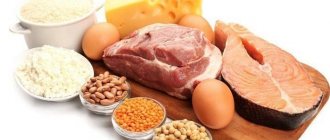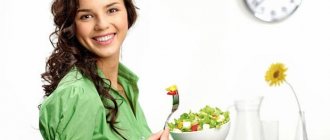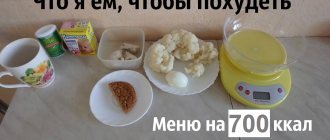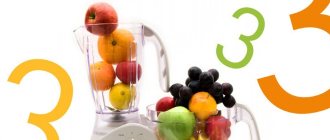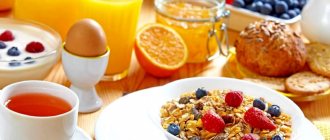The “Table No. 5” diet is a dietary diet compiled by the Soviet therapist and scientist Manuil Isaakovich Pevzner. This diet is aimed at improving the functioning of the digestive system in acute and chronic diseases of the liver, gall bladder and biliary tract.
Western scientists also confirm that including certain foods in the diet, as well as excluding others, can indeed have a tremendous impact on the health of the digestive system.
In this article we will take a comprehensive look at the therapeutic diet No. 5 according to Pevzner. We will describe the indications for its compliance. We will provide lists of prohibited and permitted products. We will tell you what effect can be expected from it for various diseases of the liver and gastrointestinal tract.
General information about diet No. 5
Manuil Isaakovich Pevzner is the founder of the so-called “gastronomic therapy” and dietetics in the USSR, a recognized honored figure of science. His works are now widely used in world dietetics.
His main work is the development of 15 diets aimed at the rehabilitation of the patient and treatment of acute and chronic diseases of the digestive tract. Diet number 5 is one of them.
As for this diet, it is designed for patients with diseases of the liver, gall bladder and biliary tract, who have impaired synthesis of gastric juice, and also have problems with the liver. In addition, this gentle diet is considered hypoallergenic.
Key aspects of this therapeutic diet:
- minimal load on the gastrointestinal tract and liver;
- providing the body with the proper amount of proteins, fats and carbohydrates (with a total calorie content of about 2.4 thousand kilocalories);
- inhibition of bile secretion (more precisely, reducing the need for its production, since “heavy” food is not included in the diet).
Table No. 5 is also suitable for regular adherence. But, according to doctors’ recommendations, you should not stick to the diet for more than 2 years, even if you have severe chronic liver diseases.
Table No. 5: Diet for the liver and gall bladder
This is interesting: Dukan diet: menu for every day, week, phases, attack, recipes, description, food table + TOP 4 stages REVIEWS
This diet was invented by Dr. Pevzner. It is the best nutritional option for people who suffer from diseases of the liver, gallbladder and biliary tract.
Table No. 5 provides the body with all the necessary nutrients, vitamins and a sufficient amount of calories. While fats and cholesterol are kept to a minimum. The diet is enriched with fiber, fruits and vegetables.
Indications for use of the diet and diet goals
Menu for the week
- Hepatitis and cholecystitis in chronic form (but not at the acute stage);
- Cirrhosis without liver failure;
- Gallstones;
- Acute cholecystitis and hepatitis at the recovery stage;
The goal of the diet is complete healthy nutrition for the whole body, which is combined with sparing the liver and normalizing the functions of bile excretion.
Nutrition Description
1A sufficient amount of proteins and carbohydrates;
2Reduced fat levels;
3All dishes can be prepared using the following thermal methods: boiling, steaming, baking, stewing.
4Products with a high fiber content must be ground or crushed in a blender. Finely chop the veined meat;
5All dishes are served warm;
6Foods high in purines and oxalic acid are excluded;
7Coarse foods with a high content of fiber, as well as extractive substances, are prohibited.
8Salt can be consumed, but in limited quantities.
Diet and diet
Food should be taken in small portions, 4-5 times a day. In the morning, on an empty stomach, it is recommended to drink a glass of warm, clean water.
The diet includes:
Proteins Up to 80 grams. Half of the required protein should be of plant origin)
Fats Up to 90 grams. (no more than 70% animal origin)
Carbohydrates Up to 400 grams
Liquid Pure drinking or mineral water without gas - about 2 liters
Salt No more than 10 grams per day
Table of permitted and prohibited products
When following a certain diet, it is very important to know what you can eat and what you cannot eat. According to the instructions of Manuil Pevzner himself, with the “table No. 5” diet, you must adhere to the following food division table:
| Name | Authorized Products | Prohibited Products |
| Beverages | Not sweet black tea | Coffee |
| Rose hip decoction | Cocoa | |
| Decoction of non-acidic dried fruits | Green tea | |
| Chamomile tea | Hot chocolate | |
| Various types of jelly (not sour, not milk) | Sour juices and compotes | |
| Soups | Any, but only with vegetable broth | Meat broth soups |
| Vegetable broths with cereals | Okroshka | |
| Porridge | Any frayed and viscous | Legumes |
| Cereal casseroles (without butter) | Pearl barley | |
| Yachnaya | ||
| Pasta | Only low-fat pasta | All other types of pasta are excluded, including egg loxin |
| Meat and fish products | Chicken breast (cook without oil) | Beef |
| Low-fat fish | Pork | |
| Oysters | Fatty fish (carp or salmon are prohibited) | |
| Shrimps | Granular caviar (black and red too) | |
| Crab sticks (they are most often prepared from fatty fish; they do not contain crabs or shrimp) |
For many diseases of the gastrointestinal tract and liver, some of the above permitted products must be excluded from the diet. Therefore, the final diet for the patient must be prepared by the doctor, taking into account the clinical picture.
What you can and cannot eat on diet 5 table: table
| Product group | What can you eat on a diet table No. 5 | What not to eat when dieting table No. 5 |
|
|
|
|
|
|
|
|
|
|
|
|
|
|
|
|
|
|
|
|
|
|
|
|
|
|
|
|
|
|
|
|
|
|
|
|
Sample menu for the week
Manuil Pevzner compiled several variations of the daily diet, taking into account possible other diseases (not only the gastrointestinal tract, but also the cardiovascular system, for example). A “universal” option in this case would be the following menu for each day of the week (again, this is only an approximate menu, its final version must be agreed upon with the attending physician):
| Eating | Monday | Tuesday | Wednesday | Thursday | Friday | Saturday | Sunday |
| Breakfast | Steamed chicken meatballs | Low-fat cottage cheese | Semolina porridge with a few raisins | Cheesecakes with dried apricots | Egg white and vegetable omelette | Oatmeal with milk | Egg white omelette with tomatoes |
| Dinner | Vegetable soup | Vegetable soup with any grated cereal | Buckwheat soup and a small piece of lean boiled beef | Pumpkin porridge | Zucchini soup without meat and cottage cheese | Chicken cutlets, possible with permitted vegetables | Minced fish cutlets |
| Dinner | Beet salad and unsweetened tea | Baked apple and non-sour compote | Fish baked in sour cream | Boiled beetroot and cabbage salad (be sure to choose non-acidic varieties) | Vegetable casserole (make it like a stew, but without any meat) | Lean beef with milk sauce | Fish soup and dried fruits (as dessert) |
As for portions, you should adhere to the following daily norm:
- 50 grams – proteins;
- 50 grams – fats;
- 400 grams – carbohydrates.
The total daily nutritional value should be about 2.4 thousand kilocalories. For obesity, it is reduced to approximately 1.8 thousand kilocalories. Again, you should always follow the instructions of the attending physician, who can visually assess the patient’s condition and create the best diet option for him.
Menu 5 tables for every day when removing the gallbladder
Forming a dietary menu can cause certain difficulties. To make this task easier, we offer an approximate weekly diet of the 5th table after removal of the gallbladder. Menu for the day First breakfast:
- Omelet from 2 egg whites or rice porridge (210 g).
- Rice pudding (90 g) or unsalted cheese (60 g).
- Tea (200 ml)
Lunch:
- Yogurt 1% fat (120 g) or low-fat cottage cheese with honey.
- Banana
Dinner:
- Vegetable puree soup (200 g).
- Boiled beef mousse (90 g).
- Stewed vegetables (110 g).
- Compote of permitted fruits and berries (200 ml)
Afternoon snack:
- Milk pudding (200 g)
Dinner:
- Steamed fish meatballs (110 g).
- Steamed vegetables (120 g).
- Kissel from permitted fruits and berries (200 ml)
Second dinner:
- Kefir 1% fat (200 ml)
Features of compliance for children
A doctor can prescribe diet number 5 even to those children who have literally only recently completed the introduction of complementary foods. Often at such a young age, due to an initially incorrectly selected diet or abuse of mixtures, problems arise in the functioning of the gastrointestinal tract, up to the suspicion of various forms of gastritis. The key features of the prescribed diet for a child are the same as for adults.
There are only a few differences:
- eat no more than 100 grams per meal (including drinks - no more than 300 grams);
- from cereals, preference is always given to rice; from milk porridges, only pearl barley can be prepared;
- from meat products - only fish (even lean chicken breast should not be used);
- milk - as much as possible, but only low-fat;
- It is also necessary to give low-fat sour cream at least once a day;
- Eat at least 100 grams of fresh fruit (not sour) daily.
Menu 5 tables for every day, recipes for children
Your child's food should be warm, but not hot. Cold dishes are excluded. The method of preparing food is extremely important. It is forbidden to eat fried, canned or smoked foods. Acceptable dishes are prepared in the following ways:
- Boiled;
- Steamed;
- Baked (rare);
- Stewed (rarely).
- When preparing food, the use of salt is reduced. This will facilitate the removal of excess water from the child’s body.
Meals throughout the day should be frequent and in small portions.
- Breakfast: Toast with butter and tea.
- Second breakfast: A glass of tea or compote.
- Lunch: Vegetable soup with croutons.
- Afternoon snack: Fruit or berry jelly.
- Dinner: Boiled chicken, side dish of boiled pasta.
Second option:
- Breakfast: Oatmeal with honey, tea with marmalade.
- Second breakfast: Oven-baked apple.
- Lunch: Milk soup with noodles.
- Afternoon snack: Some fruit.
- Dinner: Boiled beef with buckwheat porridge.
Third option:
- Breakfast: Oatmeal with pieces of fruit.
- Second breakfast: Tea with oatmeal cookies.
- Lunch: Baked fish with vegetables.
- Afternoon snack: Pumpkin casserole.
- Dinner: Chicken meatballs with rice.
Authorized Products
Authorized products
- Unsweetened cookies, yesterday's bread (or dry in a frying pan).
- Vegetable soups (vegetables are pureed), cream and puree soups. Milk soups are acceptable, but take into account the dilution of milk with water (1:1). As ingredients for soups: cereals (rice, semolina and oatmeal), finely chopped vegetables (pumpkin, carrots, potatoes). For dressing - sour cream or butter.
- Meat and fish that meet dietary requirements: lean and lean varieties. For example, turkey with chicken (can be cooked in pieces), rabbit meat and beef (in the form of puree, soufflé, etc.). Chickens must be skinned and all tendons must be removed from the meat.
- Fish is allowed only light varieties (low-fat). It can be boiled in pieces, steamed or in the form of cutlets.
- Fermented milk drinks. You can eat cottage cheese in the form of cheesecakes and puddings, pureed dishes or steamed (low-fat, homemade). Milk in the presence of colitis is allowed only as an ingredient in dishes.
- Baked egg white omelettes (yolk – no more than 1 pc/day, only for meals).
- Semolina and rice souffle or puddings. From porridges (dilute milk with water) - semolina, pureed rice, oatmeal, buckwheat. You can have boiled vermicelli.
- As for vegetables, you can eat pumpkin and zucchini in pieces (boil). Carrots and beets and cauliflower and potatoes are allowed (boil, puree, puree).
- Sweets are allowed only in the form of pureed raw and sweet (ripe, soft) berries/fruits, as well as in baked and boiled form, in the form of jelly and mousse, in the form of jelly. Be sure to wipe all dried fruits. Honey and jam are also acceptable, and marshmallows and marmalade are limited.
- All sauces are prepared with vegetable broths, or with milk, without toasted flour.
- Coffee – only weak, with added milk. Sweet juices are allowed (homemade, squeezed, diluted with water). Recommended – tea (lemon/milk), rosehip decoction.
- Butter – no more than 30 g/day. You can add refined vegetable oil to salads if your body tolerates it.
Its main principles
Before starting a diet, you must carefully familiarize yourself with its principles:
- It is necessary to consume food 5-6 times a day in small portions.
- Fasting and overeating should not be allowed. There should always be a moderate feeling of satiety.
- During the day you are allowed to drink clean drinking water and medicinal herbal teas. Other drinks are prohibited. You should drink at least 1.5 liters of liquid per day.
- The daily salt intake is 10 g. It is prohibited to exceed this norm. Consuming large amounts of salt can worsen the disease.
- It is recommended to consume vegetables in pureed form to make it easier for the stomach to digest them.
- Spicy, fatty and fried foods are prohibited. Dishes are prepared by boiling and baking.
Diet table number 1: menu for every day, permitted and prohibited foods.
What diet is indicated for chronic and acute pancreatitis of the pancreas? Read in this article.
Marshmallow jelly from ripe apricots
For this dessert you will need 200 g of very ripe apricots; it is recommended to take the Kalirovka variety. Next, the fruits are washed, the seeds are pulled out, they are ground into a puree, and the skins can be removed.
After this, the puree is mixed with 1 tbsp. l. sugar and 3 tbsp. l. boil the water after 3 minutes. add egg white whipped to peaks and 4 g of gelatin dissolved in water. The resulting mixture is poured into bowls, cooled, and the patient is served a dish at room temperature.
Important! Marshmallow is recommended in the last days of dieting during the recovery period.
According to patient reviews, this diet allows you to correct the condition, relieving pain and hastening the recovery period. The main thing is to follow the instructions correctly, and the menu for each day of diet number 5, permitted foods and regimen are prescribed by the attending physician.


